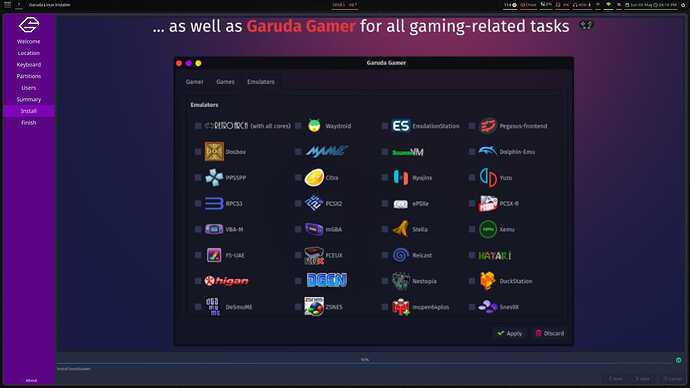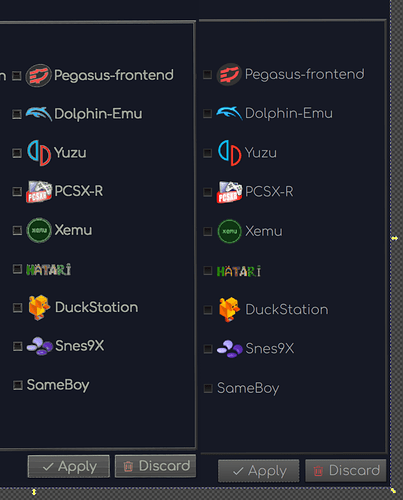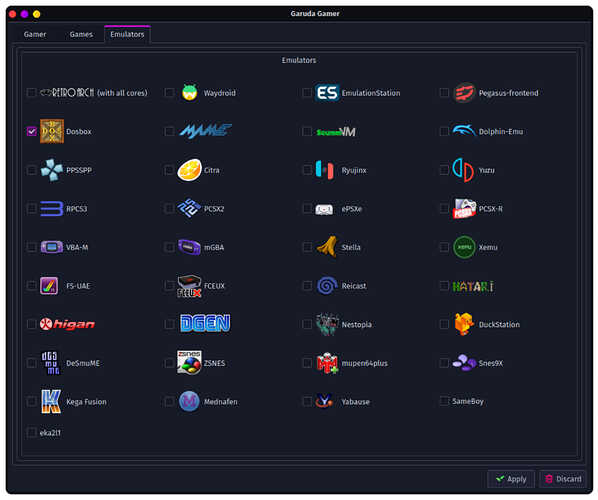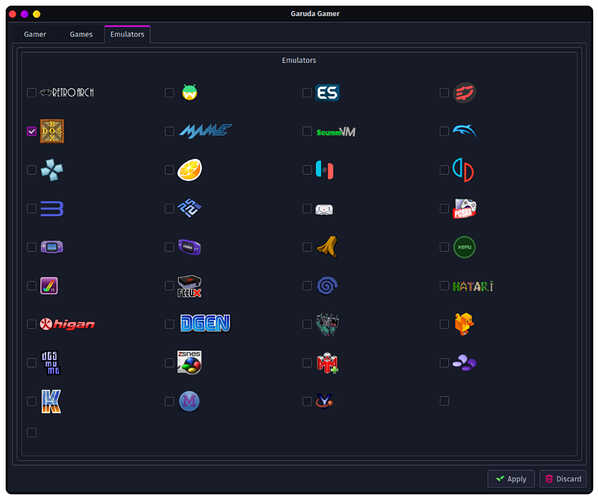Hello everyone, it’s been a while ^^
Sorry if this has already been covered elsewhere - a lot of what I found during searches were about failing to install, Calamares not launching, etc.
In the process of installing Hyprland, I noticed that the images in Calamares are quite pixelated and blurry. Here’s 2 examples:
My monitor is 2560x1440. Not sure if my Aussie internet being subpar has anything to do with it? ![]()
It’s obviously not a huge issue, but maybe worth checking out in case it’s just a one-off or a universal experience.
The ISO I experienced this in was garuda-hyprland-linux-zen-240428.iso.
garuda-inxi from the live environment:
System:
Kernel: 6.8.7-zen1-2-zen arch: x86_64 bits: 64 compiler: gcc v: 13.2.1 clocksource: tsc
avail: hpet,acpi_pm parameters: BOOT_IMAGE=/boot/vmlinuz-x86_64 lang=en_US keytable=us tz=UTC
misobasedir=garuda root=miso:LABEL=GARUDA_HYPRLAND_BIRDOFPREY quiet systemd.show_status=1
checksum=y driver=nonfree nouveau.modeset=0 i915.modeset=1 radeon.modeset=1
Desktop: Hyprland v: 0.39.1 with: waybar tools: avail: swayidle,swaylock vt: 1 dm: SDDM
Distro: Garuda base: Arch Linux
Machine:
Type: Mini-pc System: Micro (HK) Tech product: Venus series v: N/A serial: <superuser required>
Mobo: Shenzhen Meigao Equipment model: F7BSC serial: <superuser required>
uuid: <superuser required> UEFI: American Megatrends LLC. v: 1.07 date: 09/01/2023
CPU:
Info: model: AMD Ryzen 9 7940HS w/ Radeon 780M Graphics bits: 64 type: MT MCP arch: Zen 4 gen: 5
level: v4 note: check built: 2022+ process: TSMC n5 (5nm) family: 0x19 (25) model-id: 0x74 (116)
stepping: 1 microcode: 0xA704103
Topology: cpus: 1x cores: 8 tpc: 2 threads: 16 smt: enabled cache: L1: 512 KiB
desc: d-8x32 KiB; i-8x32 KiB L2: 8 MiB desc: 8x1024 KiB L3: 16 MiB desc: 1x16 MiB
Speed (MHz): avg: 1681 high: 4691 min/max: 400/5263:6228:5583:5743:5423:5903:6067 scaling:
driver: amd-pstate-epp governor: powersave cores: 1: 1993 2: 1874 3: 1874 4: 1875 5: 400 6: 400
7: 1875 8: 4690 9: 1875 10: 400 11: 400 12: 400 13: 400 14: 4691 15: 1877 16: 1873
bogomips: 127771
Flags: avx avx2 ht lm nx pae sse sse2 sse3 sse4_1 sse4_2 sse4a ssse3 svm
Vulnerabilities: <filter>
Graphics:
Device-1: AMD Phoenix1 driver: amdgpu v: kernel arch: RDNA-3 code: Phoenix process: TSMC n4 (4nm)
built: 2023+ pcie: gen: 4 speed: 16 GT/s lanes: 16 ports: active: HDMI-A-2 empty: DP-1, DP-2,
DP-3, DP-4, DP-5, DP-6, DP-7, HDMI-A-1, Writeback-1 bus-ID: c4:00.0 chip-ID: 1002:15bf
class-ID: 0300 temp: 32.0 C
Display: wayland server: X.org v: 1.21.1.13 with: Xwayland v: 23.2.6 compositor: Hyprland
v: 0.39.1 driver: X: loaded: amdgpu unloaded: modesetting alternate: fbdev,vesa dri: radeonsi
gpu: amdgpu display-ID: 1
Monitor-1: HDMI-A-2 model: Dell P2423D serial: <filter> built: 2023 res: 2560x1440 hz: 60
dpi: 123 gamma: 1.2 scale: 1 size: 527x296mm (20.75x11.65") diag: 604mm (23.8") ratio: 16:9
modes: max: 2560x1440 min: 720x400
API: Vulkan v: 1.3.279 layers: 4 device: 0 type: integrated-gpu name: AMD Radeon Graphics
(RADV GFX1103_R1) driver: mesa radv v: 24.0.5-arch1.1 device-ID: 1002:15bf
surfaces: xcb,xlib,wayland device: 1 type: cpu name: llvmpipe (LLVM 17.0.6 256 bits)
driver: mesa llvmpipe v: 24.0.5-arch1.1 (LLVM 17.0.6) device-ID: 10005:0000
surfaces: xcb,xlib,wayland
API: EGL Message: EGL data requires eglinfo. Check --recommends.
Audio:
Device-1: AMD Rembrandt Radeon High Definition Audio driver: snd_hda_intel v: kernel pcie: gen: 4
speed: 16 GT/s lanes: 16 bus-ID: c4:00.1 chip-ID: 1002:1640 class-ID: 0403
Device-2: AMD ACP/ACP3X/ACP6x Audio Coprocessor driver: snd_pci_ps v: kernel
alternate: snd_pci_acp3x, snd_rn_pci_acp3x, snd_pci_acp5x, snd_pci_acp6x, snd_acp_pci,
snd_rpl_pci_acp6x, snd_sof_amd_renoir, snd_sof_amd_rembrandt, snd_sof_amd_vangogh,
snd_sof_amd_acp63 pcie: gen: 4 speed: 16 GT/s lanes: 16 bus-ID: c4:00.5 chip-ID: 1022:15e2
class-ID: 0480
Device-3: AMD Family 17h/19h HD Audio driver: snd_hda_intel v: kernel pcie: gen: 4
speed: 16 GT/s lanes: 16 bus-ID: c4:00.6 chip-ID: 1022:15e3 class-ID: 0403
API: ALSA v: k6.8.7-zen1-2-zen status: kernel-api tools: N/A
Server-1: sndiod v: N/A status: off tools: aucat,midicat,sndioctl
Server-2: PipeWire v: 1.0.5 status: active with: 1: pipewire-pulse status: active
2: wireplumber status: active 3: pipewire-alsa type: plugin 4: pw-jack type: plugin
tools: pactl,pw-cat,pw-cli,wpctl
Network:
Device-1: Realtek RTL8125 2.5GbE driver: r8169 v: kernel pcie: gen: 2 speed: 5 GT/s lanes: 1
port: f000 bus-ID: 01:00.0 chip-ID: 10ec:8125 class-ID: 0200
IF: enp1s0 state: down mac: <filter>
Device-2: Intel Wi-Fi 6E AX210
/AX1675 2x2 [Typhoon Peak] vendor: Rivet Networks Killer
driver: iwlwifi v: kernel pcie: gen: 2 speed: 5 GT/s lanes: 1 bus-ID: 02:00.0 chip-ID: 8086:2725
class-ID: 0280
IF: wlp2s0 state: up mac: <filter>
Info: services: NetworkManager, systemd-timesyncd, wpa_supplicant
Bluetooth:
Device-1: Intel AX210 Bluetooth driver: btusb v: 0.8 type: USB rev: 2.0 speed: 12 Mb/s lanes: 1
mode: 1.1 bus-ID: 1-5:4 chip-ID: 8087:0032 class-ID: e001
Report: btmgmt ID: hci0 rfk-id: 0 state: up address: <filter> bt-v: 5.3 lmp-v: 12 status:
discoverable: no pairing: no class-ID: 6c0104
Drives:
Local Storage: total: 1.04 TiB used: 478.27 GiB (44.8%)
SMART Message: Unable to run smartctl. Root privileges required.
ID-1: /dev/nvme0n1 maj-min: 259:0 vendor: Kingston model: OM8PGP41024Q-A0 size: 953.87 GiB
block-size: physical: 512 B logical: 512 B speed: 63.2 Gb/s lanes: 4 tech: SSD serial: <filter>
fw-rev: ELFK0S.6 temp: 33.9 C scheme: GPT
ID-2: /dev/sda maj-min: 8:0 vendor: SanDisk model: Ultra USB 3.0 size: 114.56 GiB block-size:
physical: 512 B logical: 512 B type: USB rev: 3.0 spd: 5 Gb/s lanes: 1 mode: 3.2 gen-1x1
tech: N/A serial: <filter> fw-rev: 1.00 scheme: GPT
SMART Message: Unknown USB bridge. Flash drive/Unsupported enclosure?
Partition:
Message: No partition data found.
Swap:
Kernel: swappiness: 133 (default 60) cache-pressure: 100 (default) zswap: no
ID-1: swap-1 type: zram size: 60.54 GiB used: 0 KiB (0.0%) priority: 100 comp: zstd
avail: lzo,lzo-rle,lz4,lz4hc,842 max-streams: 16 dev: /dev/zram0
Sensors:
System Temperatures: cpu: 37.8 C mobo: N/A gpu: amdgpu temp: 32.0 C
Fan Speeds (rpm): N/A
Info:
Memory: total: 60 GiB note: est. available: 60.54 GiB used: 3.98 GiB (6.6%)
Processes: 364 Power: uptime: 21m states: freeze,mem,disk suspend: s2idle wakeups: 0
hibernate: platform avail: shutdown, reboot, suspend, test_resume image: 24.18 GiB Init: systemd
v: 255 default: graphical tool: systemctl
Packages: pm: pacman pkgs: 1279 libs: 376 tools: pacseek,paru Compilers: gcc: 13.2.1
Client: shell wrapper v: 5.2.26-release inxi: 3.3.34
Garuda (2.6.26-1):
System install date: 2024-05-05
Last full system update: 2024-05-05 ↻
Is partially upgraded: No
Relevant software: snapper NetworkManager dracut
Windows dual boot: <superuser required>
Failed units: gpg-agent@etc-pacman.d-gnupg.service snapper-cleanup.service






